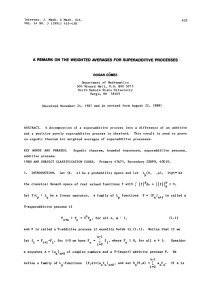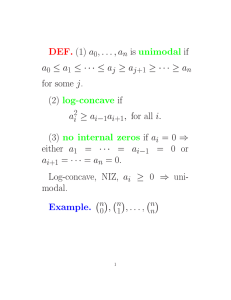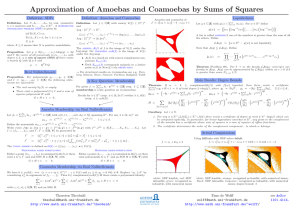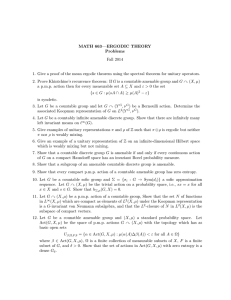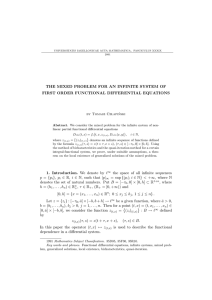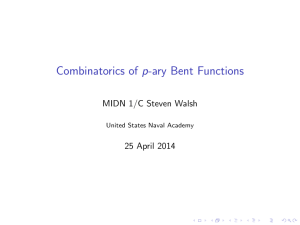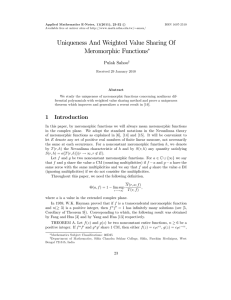R2(E) THE SPACE FUNCTIONS THE
advertisement
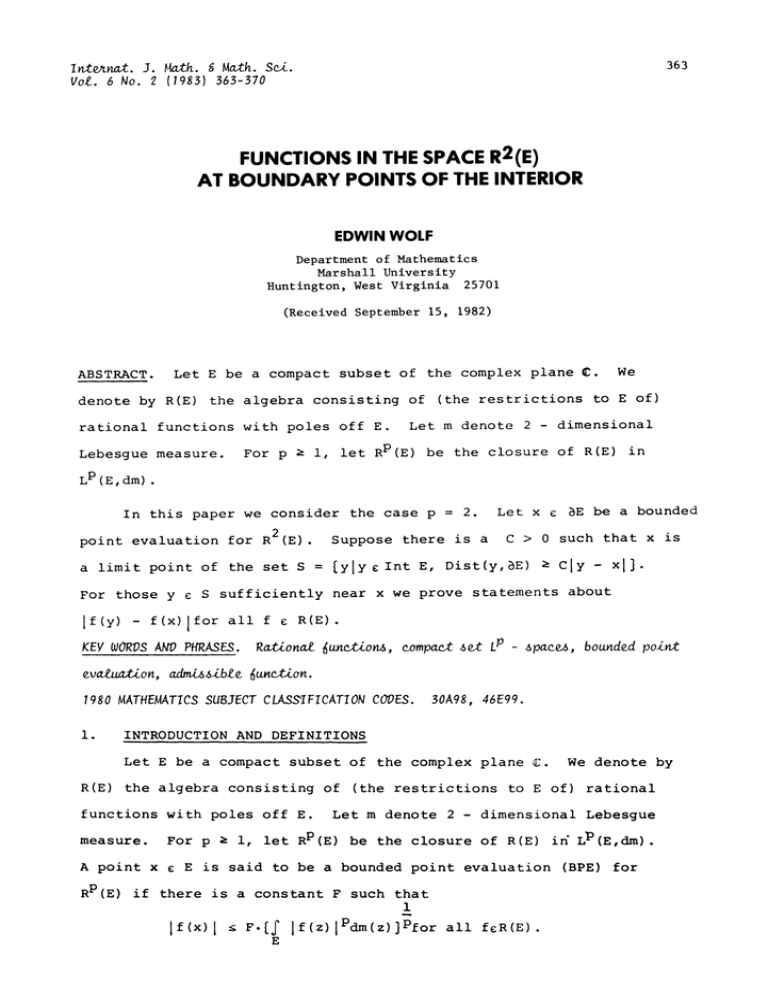
363 I ntn. J. 4ath. & Math. Sci. Vol. 6 No. 2 (1983) 363-370 FUNCTIONS IN THE SPACE R2(E) AT BOUNDARY POINTS OF THE INTERIOR EDWIN WOLF Department of Mathematics Marshall University Huntington, West Virginia 25701 (Received September 15, 1982) ABSTRACT. We Let E be a compact subset of the complex plane C. denote by R(E) (the restrictions to E of) the algebra consisting of rational functions with poles off E. For p a i, let Lebesgue measure. dimensional Let m denote 2 RP(E) be the closure of R(E) in p L (E, dm) point evaluation for R2(E). a limit point of the set S Let x c 5E be a bounded 2. In this paper we consider the case p Suppose there is a [yly C > 0 such that x is Int E, Dist(y,SE) > C ly xl]. For those y e S sufficiently near x we prove statements about f(x) for all f e R(E) If(y) KEY WORDS AND PHRASES. Rtional functions, compact set L p spaces, bounded point evaluation, adsible function. 1980 MATHEMATICS SUBJECT CLASSIFICATION CODES. i. 50A98, 46E99. INTRODUCTION AND DEFINITIONS Let E be a compact subset of the complex plane . We denote by R(E) the algebra consisting of (the restrictions to E of) rational functions with poles off E. measure. A point x RP(E) For p i, let Let m denote 2 RP(E) dimensional Lebesgue be the closure of R(E) in" LP(E,dm). E is said to be a bounded point evaluation (BPE) for if there is a constant F such that 1 If(x) < F.[ If(z)IPdm(z)]Pfor E all fcR(E). E. WOLF 364 In [4] we studied the smoothness properties of functions in RP(E), (see p > 2, at BPE’s. Fernstrm When p and Polking [2] 2, the situation is quite different Fernstrm [i]). and In [5] we 2 showed that at certain BPE’s the functions in R (E) have the following smoothness property: Let x c bE be both a BPE for R 2 (E) and the vertex of a sector contained in Int E. Let L be a line segment that bisects the sector and has an end point at x. > 0 Then for each there is a 6 > 0 such that if y c L and IY- xl If(y) < 6, f(x) llfl12 < R(E). for all f The goal of this paper is to extend this result to certain cases where there may not be a sector in Int E having vertex at x, but x is still a limit point of Int E. If x E is a BPE for R that f(x) 2(E) there is a function g e R(E). fg dm for any f L2(E) such Such a function g is called a E representing function for x. A point x e E is a bounded point derivation (BPD) of order s for R2(E) f,s, if the map f (x), f R(E), extends from R(E) to a bounded 2 linear functional on R (E). Let A (x) denote the annulus n A (x) n [z 12 -n-2 < z- x 2 < -n+l [z 12 -n-I ]. & If x z- x & 2-n]. Let 0, we will denote A n (0) by A n and A n (0) by A n For an arbitrary set X c C we let C2(X) denote the Bessel capacity of X which is defined using the Bessel kernel of order 1 (see We say that is a positive, non- is an admissible function if decreasing function defined on (0,), and r.(r) and tends to zero when r 0 [3]). -i is nondecreasing + Using the techniques of [4] and [2] one can prove: THEOREM 1.1. Let s be a nonnegative integer and E a compact set. Suppose that x is a BPE for R2(E) and is admissible. Then x is FUNCTIONS IN THE SPACE . if and only if 2. 2 e L (E) s.(I z-x[) (2-n) -2C 2 (An(X)-E) 2 2n (s+l) n=0 365 L 2 (E) such that represented by a function g g (z-x) R2(E) < THE MAIN RESULTS Let x zl that E c R2(E). 5E be a BPE for < i]. We may assume that x 0 and Suppose there is a positive constant C such that 0 is a limit point of the set S L2(E) We will construct a function g which represents 0 for R2(E) and has support disjoint from S. LEMMA 2.1. R2(E). Let 0 eE be a BPE for Suppose there is a positive constant C such that 0 is a limit point of the set S [YlY g 2 L (E) such that: (i) (ii) e Int E, Dist(y, SE) a g represents 0 for m((supp g) N S) elyl]. Then there is a function R2(E), 0, k (iii) Ig[ 2 For all n a 2, A =[] dm < F For each i, i [zl2-i-i of the set A. i C E. Let Y l < 2k C2(A2k+I n where F is a constant independent PROOF. 2 + 1 of n. 0,i,2,... consider all the intersections Izl 2- i with the bounded components of be the closure of the union of these intersections. Since Y. is compact, it can be covered by finit .ly many open discs of radius by B.. 1 <C3-12 -i-l. Let the union (finite) of these discs be denoted The set B0 is bounded by finitely many closed Jordan curves l each of which is the union of finitely many circular arcs. Each set B. is contained in a set C0 bounded by finitely many closed Jordan l curves Fij, J 1,2,..,n.l such that if z belongs to any one of these E. WOLF 366 2C3-12 -i-l. curves, Dist (z,B i) Now for each k, k 0,1,2,... choose a function 1 Co lk such that: c (1) supp (2) I k(z) 1 for z (3) ]% (z) 0 for z .k A2k+l [z12-2k-2 J 2k+l C. i=o lk (z) x where z (5) + lk(Z) kk+ l(z) j2 # (Z) -2k-3 2 2k-2 Izl Fernstrm lab 2k+2" and Polking [2] to such that: [z k dm(z) < k Dist(z,E) < ]. F-2-2k(I-JSJ)C2(Ak- E) Here the constant F is independent and k. Since supp set C (0,0), (0,1), and (1,0). for of E k l for z near A JD (2) [z 1 for z > 0 we use a lemma of obtain function k(Z) 2k+l + ix and F and F are constants independent of k. 2 1 2 Given any (l) 51k (z) 2k+l [z c kk ]. Dist(z,E) 2k+l" lk lk on the 2k+l" k 1 on [JzJ 4 -I] we have A2k+l Thus o [z JDist(z,E) < ]. h(z) X(Z) __i. where h k lkh. O with i near E. X(z) For each double index there is a constant F Set f C Choose X (0,0) such that h.E # 2k+l o Ik o # 2k+l h k (0,l) Set and (l,0) FUNCTIONS IN THE SPACE Since supp c lk the above inequalities imply that A2k+l IDShk (z) The subadditivity of C 2 367 R2(E) < F82(2k+l)(1+181) and the convergence of C2(A k 2 0 (see Theorem i.I) imply that the net If 2 is bounded in L 1. -, ,z, z e E N [zlDist(z, SE) since f e L 2 I(E), uz a for z c C Clzl]. Set g E and f(z) 5 f. 5z There 2 is a subsequence that converges weakly to a function f c which satisfi6sl f(z) E) Ll, lo c 0 for every Then g e and g is a representing function for 0. L2(E) The proof of (iii) proceeds as in [5] The above lemma can be used to prove the following theorem in almost the same way that in is used to prove [5] Lemma 5.1 Theorem 5.1. THEOREM 2.1. 2 Let 0 e 5E be a BPE for R (E). Let C be a positive constant such that 0 is a limit point of the set S [YlY Int E, Dist(y,SE) > C function for 0 and suppose that admissible function. y e S and for all f IYl IYl]" Let g -I g(z) (Izl) be a representing 2 L (E) where is an Then for any e > 0 there is a 6 > 0 such that if < 6, R(E). Using this theorem and the methods in [4] one can prove: COROLLARY 2.1. hold. Suppose that all the conditions of Theorem 2.1 Suppose, moreover, that s is a positive integer such that g(z).z-S. (Iz )-i L2(E). 6 > 0 such that if y If(y) f(0) for all f f’(0)l., R(E). Then for each c > 0 there exists a S and (y 0) Yl < 6, .... f(S)0s., (y 0)sl < lY-01s(lYl)llfll2 E. WOLF 368 Finally, there is a corollary with weaker preconditions. COROLLARY 2.2. Let 0,g, and # be as in Theorem 2.1. Suppose there is a positive constant C such that 0 is a limit point of the set y S Int E, Dist(y, BE) Y C Then for each e > 0 there is a 6 > 0 such that if y If(y) llf[12 f(0) for all f $ Yl] (IYl Yl S and < 6, R(E). The proof is similar to the proof of Theorem 2.1. such One uses the fact that there exists an admissible function that -IcL2(E) g.#-l. 3. EXAMP LES We will construct a compact set E such that 0E, 0 EXAMPLE 1. is a BPE for R [Izl & i]. 2(E), and 0 is a limit point of Int 1,2,3,..., be the open disc centered on the Let D i, i positive real axis at 3 Let E [J D0. i D 2 -i-3 Then since i=l (see [3])., we and having radius r0 1 F(log ?) C2(B(x r)) & exp(-22ii2). ,r & r o < 1 have 22nC2(A n Z n=l Let D E. E) n=l 22nC(D n) < F- .. !_ < n 1 n Thus 0 is a BPE for R2(E). Dist(y,E) a C intersects the positive real axis in a sequence If C is a positive constant sufficiently 1 Int E, will do), the se.t [YlY small (any positive number < IYl] of disjoint intervals EXAMPLE 2. an’bn ] such that bn 0. Next we construct a compact set E which is like Example 1 in that 0 is a limit point of Int E and a BPE for In this example, however, there exists no sequence that ,f(Yn f(0) < Ilfll 2,, for all f R(E) if [yn] .lYnl R2(E). c Int E such < 6. We will use FUNCTIONS IN THE SPACE important parts of positive constant r, r r < o < i. R2(E) 369 Fernstrm’s construction in [i]. 1 -i such that C2(B(z,r)) < F(log ?) Choose ,= for all a 1 such that 1 F. c n=l Let F be a nlog C2 (B(0 < 2n’ 1/2)) Cover A with be the closed unit square with center at 0 o n (i) 4 In 1 2 i squares of side 2-n. Call the squares A n (i) have and that put an open disc every set A n 2 n Let the same center, and the radius of B n (i)is exp(-4 n log n) i 1,2,3,... be an open disc centered on the positive real D i i- 1 exp < 2 and ro & axis such that D 1 c [zl 21 (i) where the summation is B 1,2,3,..., let G n For each n, n n i (i) n N ( Di 4 and B n over those indices i such that 1 < i 1 Let A o .qn Bn(i) Bn(i)such Set E J Ao 1 n=2 Gn. Then R2(EI (-22ii2). -i] zl An(i) . has no BPE’s in 5E 1 as is shown in [i]. Now replace a suitable number of the discs (i) (i)c to obtain a compact set E 2 such that 0 is the G j=2 J’ (see [1]). only boundary point of E 2 that is a BPE for B n B n R2(E2 If y e Int E 2, let norm(y) i. denote the norm of "evaluation at y" as a linear functional on This can be done so that Int E 2 D R2(E2 Then if [yk] c Di, and Yk on D. would be a BPE for ; otherwise some point Di’ nrm(Yk) R 2(E 2) For each i choose an open disc D.1 c D.1 such that D.1 and D.1 are concentric and such that if y 2 space R (E 2 D’i is greater than i. D. l D’i’ then norm(y) for the E. WOLF 370 Now let E E D 2 i=l i The radii of the D 1 are so small that 0 is also a BPE for R2(E). [yn] Let norm(y n) be any sequence in Int E such that norm of "evaluation at on Yn > 0 is there a 6 > 0 such that if lynl R2(E). < 6, 0. Yn Let Then for no f(0)lllfIl2 f(y n) R(E). for all f EXAMPLE 3. Let be an admissible function. set E in the same way that the set E Obtain a compact was obtained in Example 2 so 2 that: (i) is centered at 3 D. 1 (3. 2 -i-2 r. 1 22n (2) n=0 n=0 Let Yi 3-i. (lyil) lyi ClYilfor all i. 3 -i-2 2 -i-2 and has radius -i-2 #(2-n)-2C2(An(0) 22nc 2 (A n (x) (3) 2 2 E) -E) < for x , and 0 x D i" rl,Dist(Yi,E) a that Dist(Yi,SE) to the sequence [yi] Then by the choice of But there is no C > 0 such Hence Corollary 2.2 applies but Theorem 2.2 does not. REFERENCES 2 I. Fernstr6m, 2. Fernstrm, 3. Meyers, N. G., A theory of capacities for potentials of functions Some remarks on the space R (E) C. University of Stockholm 1982. C. and Polking, J. C., Bounded point evaluations and p approximation in L by solutions of elliptic partial differential equations. J. Functional Analysis, 28, 1-20 (1978). in Lebesgue classes, Math. Scand., 26 4. 5. Math. Reports, (1970) 255-292. Wolf, E., Bounded point evaluations and smoothness properties of functions in RP(x), Trans. Amer. Math. Soc. 238 (1978), 71-88. 2 Wolf, E., Smoothness properties of functions in R (X) at certain boundary points, Internat. J. Math. and Math Sci. 2 (1979) 415-426.


![5.5 The Haar basis is Unconditional in L [0, 1], 1 < 1](http://s2.studylib.net/store/data/010396305_1-450d5558097f626a0645448301e2bb4e-300x300.png)
